NYC’s Forgotten ‘War on Christmas Trees’
Discover how an obscure holiday crackdown affects festive street vendors today!


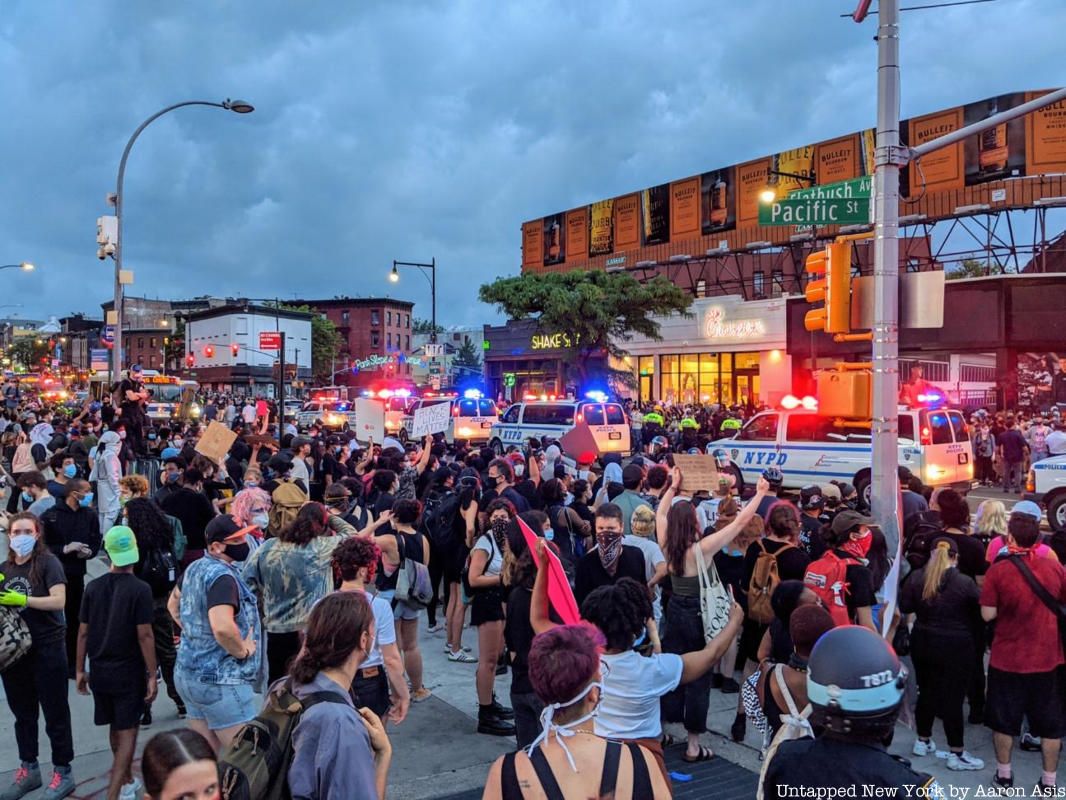
Over the weekend New York City and cities around the country have been witness to clashes between demonstrators and the police. The events were sparked by the death of George Floyd in Minneapolis, after three police officers pinned Floyd to the ground and one, Derek Chauvin, held his knee to Floyd’s neck for nearly nine minutes while Floyd calls out that he cannot breathe. You can find photographs of this weekend’s events on Untapped New York and on the social media accounts of our photographers Aaron Asis (with additional images here) and Joseph Anastasio).
As we all bear witness to what is continuing to unfold nationwide, including in the neighborhoods in Brooklyn where the Untapped New York team lives and works, we thought we could provide historical context the city’s past as a site for political expression. Going back to the colonial era, New York City has been no stranger to revolts, demonstrations, protests, and riots. Here are ten events from 1712 to the 20th century.

Slave market marker at Wall Street and Water Street
One of the first revolts in New York City’s history, the New York Slave Revolt was a 1712 uprising of enslaved Africans, which killed nine whites although 70 blacks were arrested and jailed. Although there were no large plantations in the city, New York City had one of the largest slave populations in the colonies, slaves working as domestic servants and dock workers. When the colony was transferred from the Dutch to the English, many enslaved people lost many of their rights, and slaves were required to carry around passes and were prohibited from marrying or gathering in large groups.
On April 6, 1712, a group of around 20 black slaves burned down a building on Maiden Lane in the modern-day financial district where a slave market was located, and fought back against whites who were armed with guns and hatchets. However, many of the slaves were caught and returned to their owners, some put on trial and eventually executed. The revolt ultimately led to the passage of stricter slave laws in the city, such as making it illegal to carry firearms or to gamble, and acts like property damage and conspiracy to kill could be met with the death penalty. New York saw further race- and slavery-related riots in the 19th century like the 1834 New York anti-abolitionist riots.
In 2015, New York City finally acknowledged that it was once home to one of the biggest slave markets in the country. Mayor de Blasio unveiled a plaque marking the spot on Wall Street where the slave market once stood, dedicating it to the thousands of enslaved people who passed through.
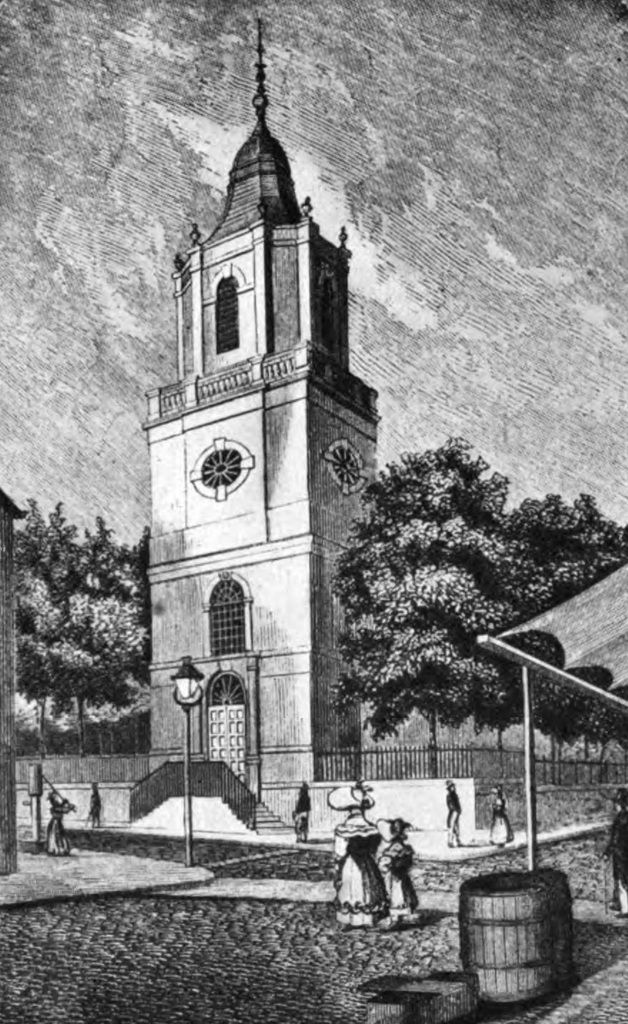
Old St. Peter’s Church at today’s 22 Barclay Street, built 1785-1786. Source: Wikimedia
A riot broke out on Christmas Eve in the city in 1806 after 50 members of the Highbinders, a nativist gang of apprentices and propertyless journeyman butchers, taunted worshippers leaving midnight mass at St. Peter’s Church. Famous congregants at the church included Elizabeth Ann Seton, the first American to be declared a saint. St. Peter’s, after its 1785 construction, was the subject of anti-Catholic sentiment, and this surfaced in 1806 after Highbinders harassed churchgoers on both Christmas Eve and Christmas, although churchgoers were ready to retaliate during the latter.
According to Gotham: A History of New York City to 1898 by Edwin G. Burrows and Mike Wallace, parishioners and Irish immigrants “armed themselves with cudgels, stones and brickbats,” and a watchman named Christian Luswanger was killed. The only people who were arrested were Irish, yet the Christmas Riots occurred less than a year following the election of the first Irish Catholic to the assembly.
The Flour Riot of 1837 was a one-day food riot in which hungry workers protested rising flour and grain prices. The riot also foreshadowed the Panic of 1837, a financial crisis that heavily impacted the city and the American economy more broadly. President Andrew Jackson had passed an executive order called the Specie Circular, which required payment of land to be in hard money, typically gold or silver. As a result, over 400 banks closed entirely or partially failed, and prices began to rise drastically for products like flour, nearly doubling from around $6 to $12 per barrel.
On February 12, around 5,000 people gathered to protest the price of flour and grain, many poor Irishmen. A speaker of unknown identity supposedly rallied the crowd to protest Hart & Co. to lower the price of flour to its original $8. Workers at Hart & Co. closed all doors and windows except one, which allowed protesters to breach the facility. The mayor was pelted with stones and ice, and after the crowd stormed the warehouse of Herrick and Co., the National Guard was called. About 500 barrels of flour were destroyed, and around 40 people were arrested during the riots. In the end, flour prices did not come down, and the depression continued until 1843.
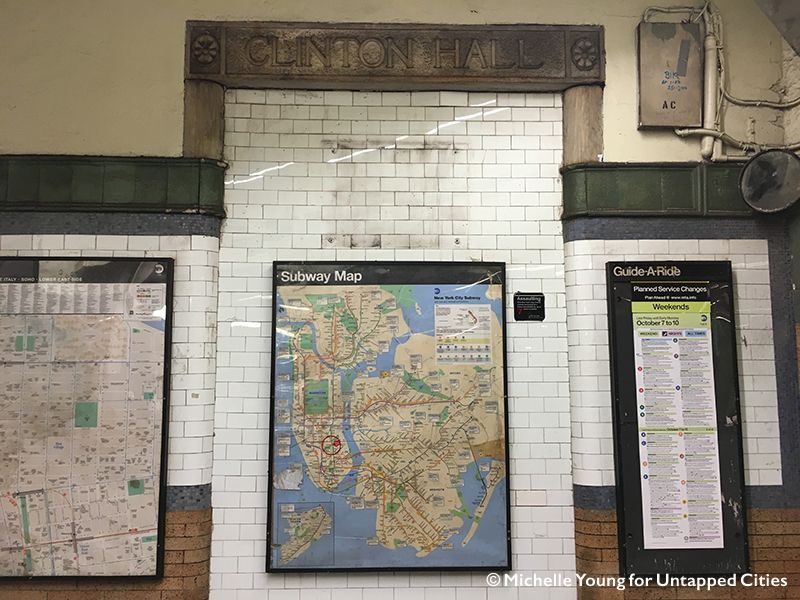
Clinton Hall, the former site of the Astor Place Opera House
The Astor Place Riot was one of the city’s deadliest riots, killing at least 25 people, at the Astor Place Opera House. The riots were sparked when supporters of American actor Edwin Forrest and English actor William Macready bickered about which actor could better play major Shakespeare roles. The riot supposedly began due to poor Anglo-American relations as well as class struggle between Macready’s supporters, who were mainly upper class, and Forrest’s middle class followers.
On May 7, Forrest’s supporters threw rotten eggs, ripped up seats, and shoes at Macready during a performance of Macbeth. Three days later, Hermann Melville and Washington Irving signed a petition for Macready to take the stage again as Macbeth. During this performance, upwards of 10,000 people stood in the streets around the theater, many Forrest supporters trying to set fire to the building. After the show, Macready left in disguise and police began opening fire after being attacked and injured, killing many innocent bystanders. The riot had the largest number of civilian casualties due to military action since the American Revolution, and police were soon after trained in riot control.

NYC Mayor Fernando Wood. Photo taken between 1855 and 1865. Image via Library of Congress
In 1857, the Great Police Riot occurred in front of New York City Hall that pitted the Municipal police against Metropolitan officers after Mayor Fernando Wood appointed Charles Devlin over Daniel Conover for the city street commissioner position. There were suspicions that Devlin paid wood $50,000 for the office, and the Metropolitan officers attempted to arrest Wood for corruption. Wood drastically increased corruption within the city, even putting forth a motion for Manhattan to secede from the Union, and as a result, the New York state legislature relieved him of control over city police. The Municipal Police were then ordered to disband and turn property over to the Metropolitan Police Department, yet they refused and coexisted with the Metropolitans for two months.
After the death of the previous street commissioner, Conover was chosen to take his place, yet Conover was forcibly removed from City Hall after Wood informed him that Devlin was appointed. Conover obtained two warrants to arrest Wood for inciting a riot and for violence against Conover. Metropolitans Captain George Walling attempted to carry out the arrest but was thrown out into the street. On the steps of City Hall, the Municipals and the Metropolitans fought before the Metropolitans were forced from the building, and 53 men were injured during the riot. However, after the Metropolitans convinced the commander of a passing navy ship that they had the legal right to arrest Wood, Wood agreed to submit although he was released one hour later. For the next few months, both police organizations interfered with each other’s arrests, and this disorganization led to the Dead Rabbits riot, a citywide gang war between the Dead Rabbits and the Bowery Boys.
 Image from New York Public Library.
Image from New York Public Library.
In 1858, before Staten Island consolidated with the rest of New York City, the New York Marine Hospital housed around 1,500 persons suffering from infectious diseases. Opened in 1799, the hospital which became known solely as the “Quarantine,” was located in the Tompkinsville section of Staten Island.
The Quarantine was accessible primarily by steamboat, and was fortified by six-foot-tall brick walls on all sides. On September 1, 1858 the site was burned down in a mob protest that stemmed from community outrage about the hazards of housing a quarantine hospital of this scale in their area.
The perception among Staten Islanders at the time was that if not for the Quarantine, there would be virtually no disease on the Island at all. Staten Islanders were convinced that illness came to their towns in two ways. One theory was that diseases were blown by the wind from infected vessels anchored offshore… Locals were also convinced that infectious diseases were carried into the community by Quarantine staff [who] reside in the village. [via Public Health Chronicles]
Thirty men approached and ransacked the establishment, which had relatively low occupancy for the night (some assume that administrators were aware of the impending attack).
The hospital staff, at first scrambling to release the animals and rescue patients, were confused to find that they had all been moved. As the mob made its way around the Quarantine grounds, setting new fires, it had swelled to several hundred people. The mob resolved to return the next day to “celebrate” the burning of the Quarantine Hospital, which resulted in the burning of any remaining buildings.Astoundingly, only two people died in the whole ordeal. One man was killed by a Quarantine worker who took the opportunity to settle an old score. Another died of yellow fever. You can read more about what happened in this riot here.

Image from Library of Congress
Also known as Draft Weeks, the New York City Draft Riots occurred from July 13-16, 1863, in Lower Manhattan in which predominantly white working-class men tried to avoid being drafting into the Civil War. Most of the rioters were Irish or of Irish descent who could not afford the $300 fee to hire a substitute. Although originally a draft riot, they eventually grew into race riots, as Irish immigrants attacked free blacks throughout the city due to increased competition for jobs. The military was deployed on the second day of the riots, but by then many public buildings, Protestant churches, black homes, and homes of abolitionists were destroyed. The final death toll is estimated to by around 120.
Fighting occurred to sites like The Provost Marshal’s Office, which saw telegraph lines cut and firefighters’ vehicles destroyed, and the Colored Orphans Asylum, the first institution to take black children whose parents had died. At the James McCune Smith Pharmacy, believed to be the first owned by an African American and entertained popular abolitionists like Frederick Douglass and John Brown, was destroyed and at least 11 black men were killed throughout the riots. Another notable site of rioting took place at the New York Times office, in which owner Henry Raymond told staff to man Gatling guns to turn back the mob. Governor Horatio Seymour spoke in front of City Hall on the second day and declared himself a friend of the protesters, proclaiming that the Conscription Act was unconstitutional. On the third day, Colonel James Barnet Fry decided to postpone the draft, and by the last day order began to be restored, despite a confrontation near Gramercy Park that saw 12 people die.

Photo by Amy Cools for Untapped Cities
The Orange Riots were New York’s second most deadly act of civil unrest, fueled by disagreements between Irish Protestants, the namesake “Orangemen,” and Irish Catholics, as well as the NYPD and the New York State National Guard. Irish laborers made up most of the over 60 civilians killed during the riots. The First Orange Riot in 1870 occurred at a parade on July 12 during which Irish Protestants commemorated William of Orange’s victory over James II at the 1690 Battle of the Boyne. Those in the parade threw insults at Irish Catholics, and the Catholics did the same back, attacking Protestants by force. The first riot saw the deaths of eight people and continued to build anger between the two groups.
However, an Irish Protestant group called the Loyal Order of Orange demanded to march again in 1871, yet City Police Commissioner James Kelso banned the parade due to fear of impending violence. This decision sparked controversy since it seemed to give Irish Catholics a platform to continue to grow in the city, and Thomas Nast penned his famous “The American River Ganges” cartoon to protest Irish Catholic power. However, the parade proceeded with extra caution and increased police presence, yet as the Protestants walked by the Catholics, they were pelted with rocks and bricks. Without any orders, police fired into the crowd, and the parade continued to Cooper Union despite a high number of casualties. Over 150 suffered casualties, and the next day, around 20,000 people gathered to mourn the death of the 60 lost lives.
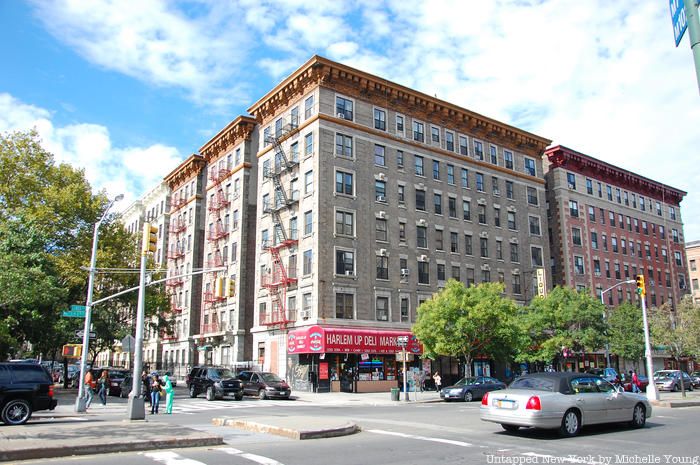
The Harlem Riots were a number of race riots through Harlem from the 1920s through the 1960s that advocated for better treatment and increased rights of African Americans. The first Harlem Riot was partly fueled by the earlier New York race riots of 1919, as part of Red Summer which saw violent attacks on black communities in many cities in the United States, many caused by social tensions like job competition or racial discrimination. The 1926 Harlem riots were mainly between over 2,000 unemployed Jews and Puerto Ricans around 115th Street over housing and jobs.
The Harlem riot of 1935 was sparked by rumors that employees at an S. H. Kress Five and Ten store beat a black Puerto Rican teenage shoplifter named Lino Rivera. Dealing with the Great Depression, many African Americans struggled with unemployment, as minorities were often the first to be fired from their jobs during rough economic times. Rivera was caught shoplifting a penknife, and after an employee threatened to beat him, Rivera bit the employee’s hand and fled. A group called the Young Liberators began a demonstration outside the store, and pamphlets were distributed reading “CHILD BRUTALLY BEATEN.” Soon after the store was looted after someone threw a rock, and protesters began looting other white-owned businesses. Three people lost their lives in the riot, which resulted in over $2 million in damages.
Eight years later, the Harlem riot of 1943 began after James Collins, a white police officer, shot and wounder an African-American soldier named Robert Bandy. The Harlem riot was one of six race-related riots in 1943, which included the Zoot Suit Riots in Los Angeles. Many protests, including this one, were fueled by segregation of black troops and workforce discrimination. While at the Braddock Hotel, a white policeman tried to arrest an African-American woman named Marjorie Polite for disorderly conflict, and soon after Polite became confrontational with Collins. After Polite checked in and was dissatisfied with her room, she protested and was asked to leave by Collins, yet Bandy hit the officer. Collins then shot Bandy, who was incorrectly believed to be dead, which resulted in a major riot resulting in six deaths and around 600 arrests.
In 1964, another Harlem riot broke out after police Lieutenant Thomas Gilligan killed a 15-year-old African American named James Powell. A superintendent in Yorkville named Patrick Lynch hosed down a group of black students, who responded by throwing bottles at Lynch. Once Powell got involved in pursuing Lynch, Gilligan shot Powell three times. Approximately 300 students joined in protest against Gilligan, and for the next six nights, around 4,000 New Yorkers participated in riots. The Congress of Racial Equality led a number of rallies in Harlem and Bedford-Stuyvesant, yet protests soon became violent as one rioter died and at least 118 were injured.
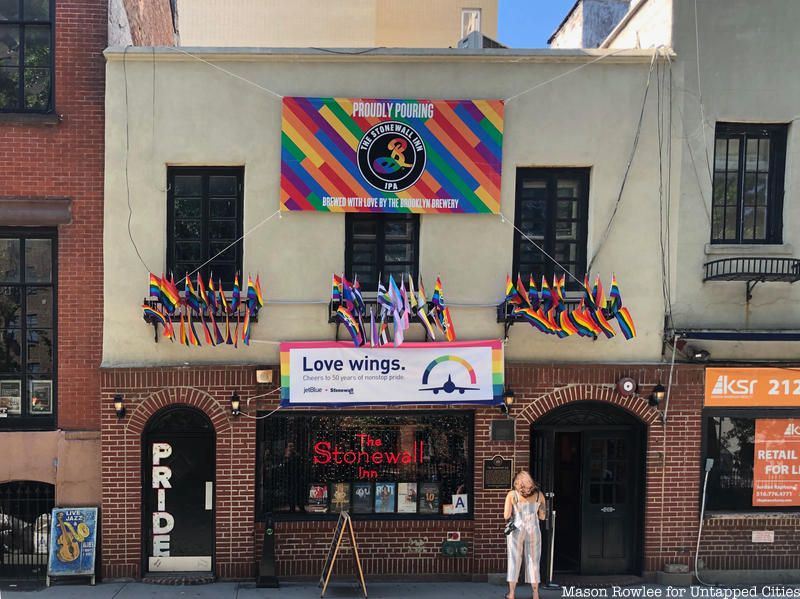
The Stonewall Riots are perhaps the most well-known riots in New York City history, sparked after a police raid on the Stonewall Inn, a gay bar and recreational tavern. During the 1960s, the LGBTQ+ community was not welcomed by many city residents and institutions, and the New York State Liquor Authority shut down establishments that served alcohol to LGBT individuals. The Mattachine Society, an organization that advocated for gay rights, openly declared their sexuality at taverns across the city and sued places that kicked them out.
Since the Stonewall Inn, purchased by the Genovese family, was not under strict police supervision, the bar lacked features like a fire exit and clean toilets. Yet, the Stonewall Inn became a major center for the LGBTQ+ community in Greenwich Village, allowing for dancing and drag queens. On June 28, the police raided the Stonewall Inn with no warning, arresting 13 people after finding bootlegged alcohol and violations of clothing statutes. Instead of fleeing, patrons and Greenwich Village residents stayed outside the Stonewall Inn, and after an officer hit a lesbian, the crowd began to throw objects at the police. Soon after, a full-fledged riot broke out, openly mocking the police while doing impromptu kick lines. The riots continued the next night around Christopher Street, and efforts continued by the LGBTQ+ community to become further integrated into NYC. One year later, gay pride marches occurred in New York, Los Angeles, and San Francisco, and gay activist organizations and newspapers were founded to advocate for their rights. The Stonewall National Monument was erected in 2016, and 50 years after the riots, Stonewall 50 – WorldPride NYC 2019 attracted around 5 million attendees in Manhattan.
Subscribe to our newsletter